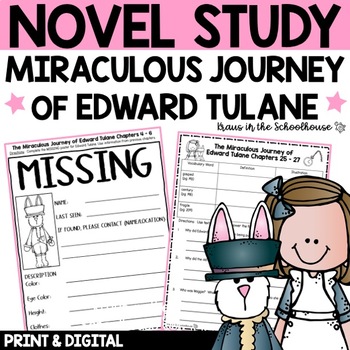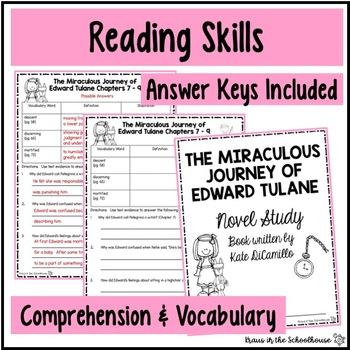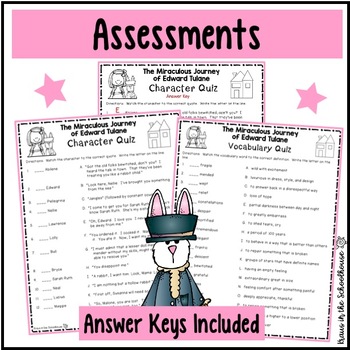The Miraculous Journey of Edward Tulane Novel Study | Read & Respond Activities
- PDF
- Easel Activity
What educators are saying
Description
Make learning fun for your students while reading The Miraculous Journey of Edward Tulane. This novel study has activities and worksheets to help students read and respond to the chapters. This resource is perfect for 3rd grade, 4th grade, and 5th grade students. Digital activity included using Easel by TpT.
These activities can be used during whole group instruction, independent work, and center time. Easy-to-use activity sheets with clear directions and answer keys are provided.
HERE'S WHAT YOU'LL GET…
- Novel Study Cover Page
- Chapters 1-3: Identify vocabulary, answer comprehension questions using text evidence, and label and describe Edward Tulane
- Chapters 4-6: Identify vocabulary, answer comprehension questions using text evidence, and create a missing poster for Edward Tulane
- Chapters 7-9: Identify vocabulary, answer comprehension questions using text evidence, and label and describe how Edward Tulane has changed
- Chapters 10-12: Identify vocabulary, answer comprehension questions using text evidence, and visualize a paragraph from the novel
- Chapters 13-15: Identify vocabulary, answer comprehension questions using text evidence, and complete graphic organizer describing details of Edward's journey
- Chapters 16-18: Identify vocabulary, answer comprehension questions using text evidence, and research constellations
- Chapters 19-21: Identify vocabulary, answer comprehension questions using text evidence, and describe character's feelings
- Chapters 22-24: Identify vocabulary, answer comprehension questions using text evidence, and identify character traits of main characters throughout novel
- Chapters 25-27: Identify vocabulary, answer comprehension questions using text evidence
- Culminating Activity: Create a newspaper identifying and describing the story elements.
- Vocabulary Quiz
- Character Quiz
- Answer Keys provided
Your students will enjoy reading and responding to The Miraculous Journey of Edward Tulane. With the variety of activity sheets, your students will have fun with this novel study.
Prep is quick and easy... just print the student worksheets and activity sheets and your students are ready to complete this novel study.
CHECK OUT THESE OTHER NOVEL STUDIES:
THANK YOU for showing an interest in this resource. CLICK HERE to follow me so you can see more resources I create. If you purchase this resource, please provide feedback. You will earn credits to use on future TpT purchases.
Copyright © Kraus in the Schoolhouse
All rights reserved by author Laurie Kraus.
Permission to copy for single classroom use only.






